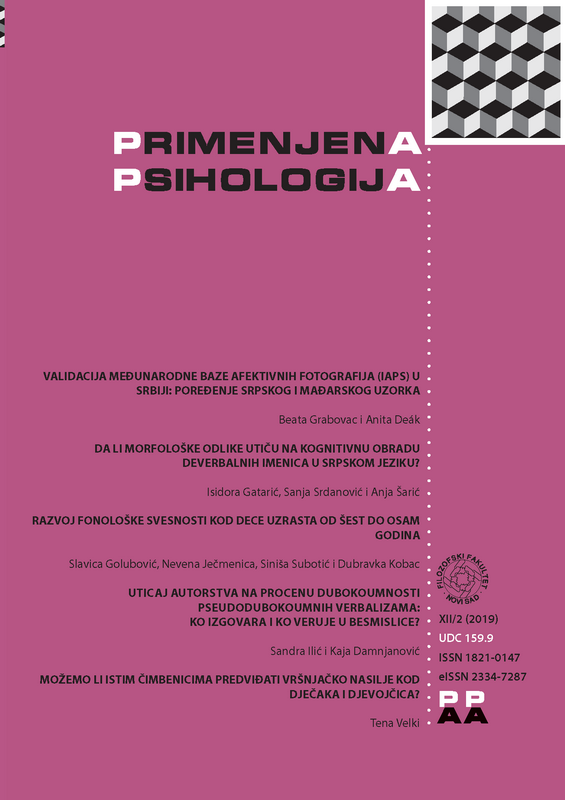DO MORPHOLOGICAL FEATURES AFFECT THE COGNITIVE PROCESSING OF DEVERBAL NOMINALS IN SERBIAN?
DOI:
https://doi.org/10.19090/pp.2019.2.139-156Keywords:
a–morphous morphology, derived nouns, deverbal nominalization, distributed morphology, morpho–lexical processingAbstract
The aim of this study was to examine whether different morphological characteristics of Serbian deverbal nominals affect their lexical processing. According to morphological differences, there are three subtypes of the process and result deverbal nominals in Serbian: (i) result nominals end with the zero suffix, while process nominals end with the deverbal suffix –nje (e.g., žubor/žuborenje [eng. burble]); (ii) result nominals differ from process nominals in the presence of the –va infix (e.g., rešenje/rešavanje [eng. solution]); (iii) process nominals end with the deverbal suffix –nje, while result nominals end with other derivational suffixes (e.g., rotiranje/rotacija [eng. rotation]). The final results of three self–paced reading experiments suggest that different morphological features do not affect the processing of deverbal nominals, which strongly supports a–morphous approach to the morpho– lexical processing, as well as the distributed morphology perspective in the field of theoretical linguistics.
References
Anderson, S. (1992). A–morphous morphology. Cambridge: Cambridge University Press. doi:10.1017/CBO9780511586262.001
Baayen, R. H. (2008). Analyzing Linguistic Data: A Practical Introduction to Statis- tics Using R. United States: Cambridge University Press.
Baayen, R. H., & Milin, P. (2010). Analyzing Reaction Times. International Journal of Psychological Research, 3(2), 12–28. doi:10.21500/20112084.807
Baayen, R. H. (2011). Corpus linguistics and naive discriminative learning. Bra- zilian Journal of Applied Linguistics, 11, 295–328. doi:10.1590/S1984– 63982011000200003
Belsley, D. A., Kuh, E., & Welsch, R. E. (1980). Regression Diagnostics. Identifying Influential Data and Sources of Collinearity. New York: Wiley Series in Prob- ability and Mathematical Statistics.
Bertram, R. (2011). Eye movements and morphological processing in reading. The Mental Lexicon, 6(1), 83–109. doi:10.1075/bct.47.14ber
Bybee, L.J. (1985). Morphology: A Study of the Relation Between Meaning and Form. Amsterdam: John Benjamins Publishing Company. doi:10.1075/tsl.9
Gatarić, I., Srdanović, S., Nenadić, F., & Šarić, A. (2019, March). The cognitive pro- cessing od process and result deverbal nominals in English and Serbian. Paper presented at the 25th Empirical Studies in Psychology, Belgrade, Serbia.
Gatarić, I. (2019). The cognitive processing of derived nouns with ambiguous suf- fixes: behavioral and eye–movement study. Primenjena psihologija, 12(1), 85–104. doi:10.19090/pp.2019.1.85–104
Gelman, A., & Hill, J. (2007). Data Analysis Using Regression and Multilevel/Hi- erarchical Models. Cambridge: Cambridge University Press. doi:10.1017/ cbo9780511790942.029
Grimshaw, J. (1990). Argument Structure. Cambridge: The MIT Press.
Halle, M. (1990). An approach to morphology. In J. Carter, R. M. Dechaine, B. Philip, & T. Sherer (Eds.), Proceedings of NELS 20 (pp. 150–184). Amherst: GLSA.
Halle, M. (1997). Distributed morphology: Impoverishment and fission. In B. Bru- ening, Y. Kang, & M. McGinnis (Eds.), MITWPL 30: Papers at the Interface (pp. 425–449). Cambridge: MIT WPL. doi:10.1075/cilt.202.07hal
Ignjatović, M. (2012). Result States and Nominalization in Slavic and Germanic Languages. Proceedings of Sinn und Bedeutung, 17, 289–306.
Kostić, A. (2010). Kognitivna psihologija [Cognitive psychology]. Beograd: Zavod za izdavanje udžbenika.
Kennison, S. M. (1999). Processing Agentive By –Phrases in Com- plex Event and Nonevent Nominals. Linguistic Inquiry, 30, 502–508. doi:10.1162/002438999554183
Ljubešić, N., & Klubička, F. (2016). The Serbian web corpus srWaC. Ljubljana: Jožef Stefan Institute. Retrieved from: http://nl.ijs.si/noske/all.cgi/first_ form?corpname=srwac;align
Mathôt, S., Schreij, D., & Theeuwes, J. (2012). OpenSesame: An open–source, graphical experiment builder for the social sciences. Behavior Research Meth- ods, 44(2), 314–324. doi:10.3758/s13428–011–0168–7
Matracki, I., & Kovačić, V. (2016). Some characteristics of deverbal nominals in Slavic and Romance languages. Linguistik Online, 77(3), 29–70. doi:10.13092/ lo.77.2906
Manouilidou, C. (2006). On the processing of thematic features in deverbal nomi- nals (Upublished doctoral dissertation). Canada: Department of Linguistics, Faculty of Arts, University of Ottawa.
Manelis, L., & Tharp, D. (1977). The processing of affixed words. Memory and Cog- nition, 5(6), 690–695. doi:10.3758/BF03197417
Milin, P., Feldman, L. B., Ramscar, M., Hendrix, P., Baayen, R. H. (2017). Discrimina- tion in lexical decision. PLoS ONE, 12(2), e0171935. doi:10.1371/journal. pone.0171935
Milin, P., Divjak, D., Dimitrijević, S., & Baayen, H. (2016). Towards cognitively plau- sible data science in language research. Cognitive Linguistics, 27(4), 507–526. doi:10.1515/cog–2016–0055
Paul, I. (2014). Cross–linguistic Investigations of Nominalization Patterns. Amster- dam: John Benjamins Publishing Company.
Plag, I., & Winter Balling, L. (in press). Derivational morphology: An integrative perspective on some fundamental issues. In V. Pirelli, I. Plag, & W. Dressler (Eds.), Word knowledge and word usage: A cross–disciplinary guide to the mental lexicon. Berlin: De Gruyter.
R Core Team (2017). R: A language and environment for statistical computing. Vienna: R Foundation for Statistical Computing. Retrieved from: http:// www.R–project.org/
Radman, S. (2015). Cognitive processing of result and process nominals in English and Serbian (Unpublished master thesis). Serbia: Faculty of Philosophy, Uni- versity of Novi Sad.
Rayner, K. (1998). Eye Movements in Reading and Information Processing: 20 Years of Research. Psychological Bulletin, 124(3), 372–422. doi:10.1037//0033– 2909.124.3.372
Smirnova, A. (2015). Understanding Deverbal Nominals: World Knowledge or Lexical Semantics? CogSci, 2224–2229.
Srdanović, S., Gatarić, I., & Šarić, A. (2018, February). Theoretical and empirical vi- dimus of the simple event nominals (non) existence in Serbian. Paper presented at the 9th Linguistic Evidence: Experimental Data Drives Linguistic Theory, Tübingen, Germany.
Taft, M. (2004). Morphological decomposition and the reverse base frequen- cy effect. Quarterly Journal of Experimental Psychology, 57A, 745–765. doi:10.1080/02724980343000477
Taft, M., & Forster, K. I. (1975). Lexical storage and retrieval of prefixed words. Journal of Verbal Learning and Verbal Behavior, 14, 638–647. doi:10.1016/ s0022–5371(75)80051–x
Van Rij J., Wieling M., Baayen R., & van Rijn H. (2016). itsadug: Interpreting Time Series and Autocorrelated Data Using GAMMs. R package version 1.0.1.
Wood, S. N. (2006). Generalized Additive Models: An Introduction with R. United States: Chapman and Hall/CRC.
Wood, S. N. (2011). Fast stable restricted maximum likelihood and marginal likeli- hood estimation of semiparametric generalized linear models. Journal of the Royal Statistical Society, 73(1), 3–36. doi:10.1111/j.1467–9868.2010.00749.x
Zlatić, L. (1997). The structure of the Serbian noun phrase (Unpublished doctoral dissertation). United States: University of Texas at Austin.







